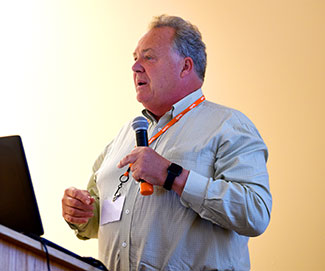Improved DNA Testing for Cattle
Rare variation may be the silver bullet cattle producers never knew they needed.
by Lindsay King, Angus Journal assistant editor
BROOKINGS, S.D. (June 19, 2019) — A new genotyping assay may be able to find the variation researchers have been searching for all along, said Jerry Taylor, Curators’ Professor of Genetics and Animal Sciences and Wurdack Chair of Animal Genomics at the University of Missouri (MU). He spoke on the topic at the 2019 Beef Improvement Federation (BIF) research symposium in Brookings, S.D., June 18-21.
“There are some incredible opportunities for beef cattle breeding using genotype imputation,” Taylor said. The process of imputation is twofold: (1) sort alleles on each chromosome, which is called phasing, and (2) estimate the missing genotypes.

Bruce Golden
The genome is made up of 24,000 genes, and only 10% of those are required for sustaining life. That leaves a lot of room for mutations to occur and wreak havoc on an animal. [Photo by Julie Mais]
“GGP-F250 is a new genotyping assay that was developed in collaboration with GeneSeek and the University of Missouri,” he said. “It’s a very different assay compared to the ones that exist today.”
There are two types of variation on a chromosome: common variant and rare variant. Current assays measure common variants, while the GGP-F250 assay does not.
“This is important because most variation in the genome is caused by the rare variants,” Taylor said. “This accounts for differences in EPDs (expected progeny difference values) for example. We are not currently capturing that with the assays we have available.”
The genome is made up of 24,000 genes, and only 10% of those are required for sustaining life. That leaves a lot of room for mutations to occur and wreak havoc on an animal.
“As an example, I have a 50K genotype on EXT, and I want to see if I can estimate his whole genome sequence and every variation within that,” Taylor said. “That’s very aggressive, but it can be done.”
Imputing rare variance is incredibly difficult and inaccurate for a number of reasons, but Taylor boils it all down.
“The assays we are using don’t have rare variance on them, they are all common variance,” Taylor said.
Troy Rowan, a fellow MU researcher, has been addressing this issue for the last year. He recently released an online “imputation pipeline” to make rare variance imputation a breeze. Taylor and his students have been routinely sending the data from an animal genotyped with a 50K chip through the pipeline. Out the other end comes a genome with all the gaps basically filled in.
“Using this tool we can take the 50K data that every breed association has and put it through this free tool to get 850,000 variants,” Taylor said. “Over 100,000 of those variants are rare.”
Through this endeavor, Taylor said, he has found that heritability is higher when rare variation is included. This essentially gives producers and breed associations opportunity to increase the accuracy of EPDs and subsequent selection responses.
“Breed associations need to evaluate the utility of rare variant imputation for the National Cattle Evaluation (NCE),” he added.
The practical application of this innovative technology pertained mostly to embryonic loss for Taylor. His research revealed strong evidence that 76 regions on the Angus genome are responsible for embryonic loss. Using the imputation method, tests and EPDs could easily be developed to find the answer.
“We need to consider how much diversity we have in our breeds,” Taylor said. “People are always worried that we are inbreeding too much and losing all the diversity we had.”
They just might be right, but the proof is in the genome.
The 2019 BIF Annual Convention was hosted by South Dakota State University and the South Dakota Beef Breeds Council June 18-21 at the University Comfort Suites and Convention Center in Bookings. ANGUS MEDIA® provides comprehensive online coverage of the event at www.BIFconference.com. Visit the Newsroom for summaries, proceedings, PowerPoints, video and/or audio of the sessions and the Awards page for announcements and photos of award winners.
Editor’s Note: This summary was written under contract or by staff of ANGUS MEDIA®. Through an agreement with the Beef Improvement Federation,
we encourage reprinting of the articles to those who will adhere to the
reprint guidelines available on this site. Please review those
guidelines or contact Shauna Rose Hermel,
editor, at 816-383-5270. PowerPoints are posted with permission of the
presenter and may not be reproduced in whole or in part without the
express permission of the presenter. We welcome educational venues and
cattlemen to link to this site as a service to their audience.
For questions about this site, or to notify us of broken links, click here. Look for additional coverage in the Angus Journal, the Angus Beef Bulletin, the Angus Journal Daily, the Angus Beef Bulletin EXTRA and Angus TV.


